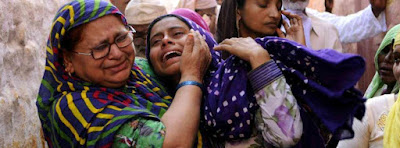The Modi Years
The ruling party’s leaders have supported violence in the name of cow protection.
Design | Nithya Subramanian
Feb 23, 2019 · 07:30 pm
Shoaib Daniyal
The past five years of the Modi government have seen a spate of mob attacks across India. The elements that fuelled this bloody mix include religious fanaticism (specifically, cow protection), increased penetration of social media and politicians, who ranged from being apathetic to instigators of violence.
Dadri, 2015
......
Dadri is a small Uttar Pradesh town on the peri-urban edges of the National Capital Region. On September 28, 2015, villagers in Bisahra village close to Dadri, accused Mohammed Akhlaq of stealing and slaughtering a calf for Eid, which was three days ago. Later, an announcement was allegedly made from the local temple’s public address system to gather a mob, which then proceeded to Akhlaq’s house. Akhlaq and his son Danish were dragged out and beaten with rods and bricks. Their fridge was raided and a leftover meat curry was seen as proof that they had killed a cow (Akhlaq’s family insisted it was goat meat). Akhlaq died from the assault. Danish was severely injured and had to undergo brain surgery later. .......
Relatives of Mohammad Akhlaq mourn after he was killed by a mob in Dadri. Photo: Reuters
Unleashing a flood
Dadri set a template. Cow protection vigilantes would assault men they accused of either killings cows or transporting cattle to be slaughtered. Moreover, these would then not be treated as ordinary crimes. The vigilantes would often be supported, sometimes explicitly, by political parties and governments. In March 2016, two cattle traders were lynched and their bodies hung up from a tree in Jharkhand. In July 2016, four Dalit men were assaulted in Una, Gujarat for skinning dead cows and their assault filmed by the perpetrators themselves. .......
Beyond gau raksha
........
On June 27, 2017, a mentally ill woman was lynched in West Bengal after a 14-year old child went missing in the area with and rumours of Bangladeshi child abductors being active in the area. In June, 2018, a mob in Assam beat two young men to death – again on the suspicious on being child lifters. During the assault, the victims pleaded with the assaulters that they were Assamese – even listing their parents’ names but the mob did not listen. May 2018 saw multiple mob attacks in Andhra Pradesh of Hindi-speaking people as false rumours spread that child abductor gangs from Bihar and Jharkhand were active in the state. Two months later, five men from a nomadic tribe were beaten to death in Maharashtra.
Women mourn the loss of their relatives in a mob attack in Dhule. Phone: Shone Satheesh
Political reactions
......
Politically, the reaction to mob violence was either muted or in support of it. After the Bulandshahr killing, one BJP MLA argued that the policeman had actually shot himself and the rampaging mob had not role to play.
Prime Minister Modi had not said much on the violence in spite of the clear danger it represents. In 2017, he appealed for people to not take the law in their hands in case they suspect cow slaughter but allow the legal system to do its work (a large number of Indian states have made slaughtering cattle illegal). In 2019, Modi again condemned lynchings but also asked rhetorically if they began only in 2014.
So strong is the force of the mob that even the Opposition has been muted on the issue. The Congress has said little on how it intends to tackle lynchings and neither have any of the other parties in North and West India even as the general elections approach.
The only movement on the issue has been from WhatsApp, by far India’s most popular mobile phone messaging service. In July, 2018, the company limited forwarding of messaged to five chats at a time in a bid to curb rumours.
Read full article: scrollin
The ruling party’s leaders have supported violence in the name of cow protection.
Design | Nithya Subramanian
Feb 23, 2019 · 07:30 pm
Shoaib Daniyal
- The past five years have seen mob lynchings across India
- Factors driving violence include cow protection movements and penetration of social media
- The effects are significant with a near-collapse of the rural cattle trade and worsening law and order
- In spite of the threat to law and order, political reaction has either been muted or has supported vigilante action
The past five years of the Modi government have seen a spate of mob attacks across India. The elements that fuelled this bloody mix include religious fanaticism (specifically, cow protection), increased penetration of social media and politicians, who ranged from being apathetic to instigators of violence.
Dadri, 2015
......
Dadri is a small Uttar Pradesh town on the peri-urban edges of the National Capital Region. On September 28, 2015, villagers in Bisahra village close to Dadri, accused Mohammed Akhlaq of stealing and slaughtering a calf for Eid, which was three days ago. Later, an announcement was allegedly made from the local temple’s public address system to gather a mob, which then proceeded to Akhlaq’s house. Akhlaq and his son Danish were dragged out and beaten with rods and bricks. Their fridge was raided and a leftover meat curry was seen as proof that they had killed a cow (Akhlaq’s family insisted it was goat meat). Akhlaq died from the assault. Danish was severely injured and had to undergo brain surgery later. .......
Relatives of Mohammad Akhlaq mourn after he was killed by a mob in Dadri. Photo: Reuters
Unleashing a flood
Dadri set a template. Cow protection vigilantes would assault men they accused of either killings cows or transporting cattle to be slaughtered. Moreover, these would then not be treated as ordinary crimes. The vigilantes would often be supported, sometimes explicitly, by political parties and governments. In March 2016, two cattle traders were lynched and their bodies hung up from a tree in Jharkhand. In July 2016, four Dalit men were assaulted in Una, Gujarat for skinning dead cows and their assault filmed by the perpetrators themselves. .......
Beyond gau raksha
........
On June 27, 2017, a mentally ill woman was lynched in West Bengal after a 14-year old child went missing in the area with and rumours of Bangladeshi child abductors being active in the area. In June, 2018, a mob in Assam beat two young men to death – again on the suspicious on being child lifters. During the assault, the victims pleaded with the assaulters that they were Assamese – even listing their parents’ names but the mob did not listen. May 2018 saw multiple mob attacks in Andhra Pradesh of Hindi-speaking people as false rumours spread that child abductor gangs from Bihar and Jharkhand were active in the state. Two months later, five men from a nomadic tribe were beaten to death in Maharashtra.
Women mourn the loss of their relatives in a mob attack in Dhule. Phone: Shone Satheesh
Political reactions
......
Politically, the reaction to mob violence was either muted or in support of it. After the Bulandshahr killing, one BJP MLA argued that the policeman had actually shot himself and the rampaging mob had not role to play.
Prime Minister Modi had not said much on the violence in spite of the clear danger it represents. In 2017, he appealed for people to not take the law in their hands in case they suspect cow slaughter but allow the legal system to do its work (a large number of Indian states have made slaughtering cattle illegal). In 2019, Modi again condemned lynchings but also asked rhetorically if they began only in 2014.
So strong is the force of the mob that even the Opposition has been muted on the issue. The Congress has said little on how it intends to tackle lynchings and neither have any of the other parties in North and West India even as the general elections approach.
The only movement on the issue has been from WhatsApp, by far India’s most popular mobile phone messaging service. In July, 2018, the company limited forwarding of messaged to five chats at a time in a bid to curb rumours.
Read full article: scrollin








